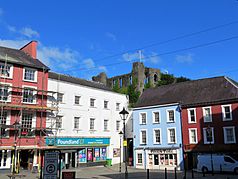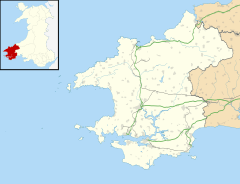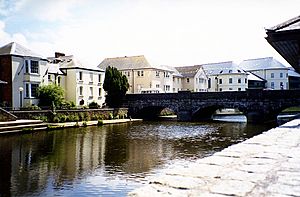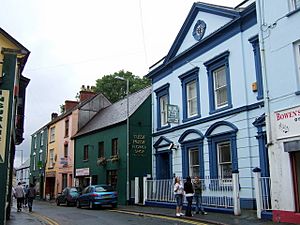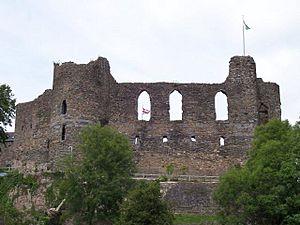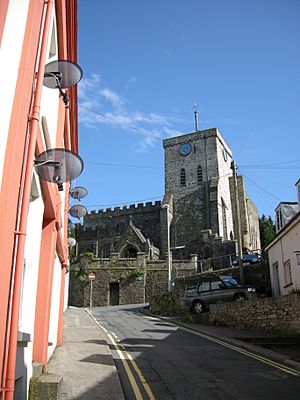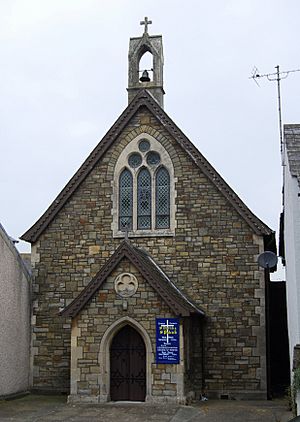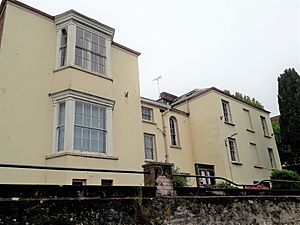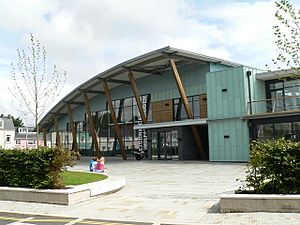Haverfordwest facts for kids
Quick facts for kids Haverfordwest
|
|
|---|---|
|
|
|
| Population | 12,042 (Community 2011) |
| OS grid reference | SM955155 |
| Community |
|
| Principal area | |
| Ceremonial county | |
| Country | Wales |
| Sovereign state | United Kingdom |
| Post town | HAVERFORDWEST |
| Postcode district | SA61, SA62 |
| Dialling code | 01437 |
| Police | Dyfed-Powys |
| Fire | Mid and West Wales |
| Ambulance | Welsh |
| EU Parliament | Wales |
| UK Parliament |
|
| Welsh Assembly |
|
Haverfordwest (pronounced HAV-er-fərd-WEST) is the main town of Pembrokeshire, Wales. It is the largest urban area in Pembrokeshire, with about 14,596 people living there in 2011. The Welsh name for the town is Hwlffordd.
Haverfordwest is important because of its location. It was the lowest point where you could cross the Western Cleddau river by bridge. This was before the Cleddau Bridge opened in 1975. The town includes areas like Prendergast, Albert Town, and Withybush. Withybush has homes, shops, a hospital, and an airport.
Contents
- Exploring Haverfordwest's Location and Features
- A Look at Haverfordwest's Past
- How Haverfordwest is Governed
- Population of Haverfordwest
- Haverfordwest's Economy
- Schools and Learning in Haverfordwest
- Sports and Fun in Haverfordwest
- Getting Around Haverfordwest
- Famous People from Haverfordwest
- Honours for Haverfordwest
- Images for kids
- See also
Exploring Haverfordwest's Location and Features
Haverfordwest is a market town and the main town of Pembrokeshire. It is a key transport hub for roads connecting to Milford Haven, Pembroke Dock, Fishguard, and St David's. This is because it sits at the point where the Western Cleddau river's tide stops.
Most of the town is on the west side of the river. This includes the old areas of St. Mary, St. Martin, and St. Thomas. On the east side are the areas of Prendergast and Cartlett. The river cuts through two sandstone ridges here. This creates two high areas on the west side of the river.
The castle and its nearby settlement are on the northern high area. The High Street, which goes steeply up from the river, is on the southern high area. Old bridges cross the river to Prendergast from the bottom of these areas. These are St Martin's Bridge (the "Old Bridge") and St Mary's Bridge (the "New Bridge," built in 1835).
Besides the four old parish churches, you can also see the remains of an Augustinian priory. This old religious building is at the southern edge of the town.
What Does the Name Haverfordwest Mean?
The town's name means "ford used by heifers" or "ford used by goats." It comes from the Old English word hæfer. Locally, people often say "Harford." The word "West" was added in the 1400s. This was to tell it apart from Hereford in England. On a 1578 map of Pembrokeshire, it is called Herfordwest. The Welsh name, Hwlffordd, is thought to be a changed version of the English name.
A Look at Haverfordwest's Past
Haverfordwest has been English-speaking for many centuries. The southern part of Pembrokeshire is even called 'Little England Beyond Wales'. However, because markets traded with Welsh farmers, there has always been a strong Welsh influence. The area of Prendergast was likely a place where Welsh workers lived. This was from a time when all farm trade had to go through the town. The Normans, who were in power, tried to stop Welsh people with weapons from entering the castle walls at night.
How Haverfordwest Began
Many Iron Age and Roman coins and items have been found here. This suggests that the Romans were present in this western part of Wales. Haverfordwest's location was very important. It had a good defensive spot overlooking the lowest river crossing. It was also easy to reach by sea. This would have needed a Roman presence to protect supplies. For example, the Roman headquarters at Caerleon used slates from the nearby Preseli Hills.
In 1992, photos from the air showed a Roman road near Haverfordwest. This suggests there might have been Roman forts at river crossings. Old records also mention finds of Roman silver coins in the town.
Some historians believe the town's name before the Normans was Caer Alun. This name might have come from Emperor Maximus. He was the last Roman Emperor of Britain. He gave civic status and Celtic names to some Roman-British settlements. Maximus had married a Welsh noblewoman named Elen. Some say the town was first named Caer Elen, in her honour.
Haverfordwest in Medieval Times
The main religious center in the area was likely one of the churches of St Ismael. This happened around 1110.
Haverfordwest Castle was probably built around 1100 by the Norman Gilbert de Clare. The Flemings, who were people from what is now Belgium and the Netherlands, arrived later. They likely helped develop the castle for their own safety and the Normans' safety from Welsh leaders.
The Flemings were often mercenaries, soldiers who fought for money. They were given land in parts of Wales. However, they were not always popular where they settled. In 1136, the Normans and Flemings faced a big defeat against a Welsh army.
St Mary's Church was first built in the late 1100s. The current building was constructed between the 1200s and 1400s. It is a very noticeable building at the top of High Street.
Haverfordwest grew quickly, first around the castle. It became the capital of the Roose area. It was also the main trading center of western Dyfed, and it still is today. By 1300, the town was about the same size as it was in the early 1800s. It was a large town for its time, with perhaps 4,000–5,000 people.
The town received its first special permission for trade from William Marshall, 1st Earl of Pembroke. This allowed it to have profitable trading rights as an English borough. It traded by land and sea, and had a busy quay on the river. Many different guilds (groups of skilled workers) operated here. There was also a lot of woollen cloth made.
In 1545, Henry VIII made the town a "county corporate". This meant it was like its own county, separate from Pembrokeshire. This was done to help fight piracy in the local waters. Haverfordwest was one of only two such counties in Wales. It remained "The Town and County of Haverfordwest" until 1974.
Like other large towns in Europe, Haverfordwest was badly affected by the Black Death in 1348. Its population dropped, perhaps by more than half, and trade decreased. Many parts of the town were left empty. It did not start to recover until the Tudor period. By the late 1600s, the town was still smaller than it had been in 1300. In 1405, the town was burned by the French allies of Owain Glyndŵr.
Haverfordwest After the Medieval Period
During the English Civil War, the town's citizens supported Parliament. However, the local wealthy families supported the King. This led to a lot of fighting, and the town changed hands five times. After this, the town's importance declined for a while.
Haverfordwest in the 20th Century
About 1,200 men from Pembrokeshire died in World War I. Haverfordwest was chosen for the County of Pembroke War Memorial, which was revealed in 1921. It is now in Picton Place, near County Hall.
Haverfordwest was bombed during World War II on September 24, 1940. The City Road and New Road areas were hit. Luckily, no one was hurt.
Today, Haverfordwest feels like a typical small country market town. But the center still shows signs of its important medieval past. The riverside area, which used to be run-down, has been improved. Bridge Street is now a pedestrian-only area.
Several places in Pennsylvania, United States, are named after Haverfordwest. These include Haverford Township, Haverford, and Havertown.
Haverfordwest in the 21st Century
In October 2022, archaeologists found the remains of 307 people, including children. They were found under an old department store building. This was once a medieval priory. It is thought that this burial ground was used until the early 1700s.
How Haverfordwest is Governed
Local and National Government
Haverfordwest is part of the Preseli Pembrokeshire Senedd constituency. The Senedd is the Welsh Parliament. The local Senedd Member is Paul Davies.
For the UK Parliament, Haverfordwest is in the Mid and South Pembrokeshire constituency. It is currently represented by Henry Tufnell.
Historically, Haverfordwest had its own Member of Parliament from the 1500s. This was very rare for a Welsh town.
Changes in Local Administration
Haverfordwest was an ancient borough. It received its first special permission from Henry II in 1169. This allowed it to appoint its own sheriff in 1479. In 1545, it was declared a "county corporate". This meant it was independent from Pembrokeshire.
In 1889, the town came under the control of Pembrokeshire County Council. However, it kept some independence. It had its own Lord Lieutenant until 1931. It also kept its own Quarter Sessions (local courts) until 1951. The status of "county corporate" finally ended in 1974. Haverfordwest still has the right to appoint its own sheriff today.
Haverfordwest used to have a medieval guildhall. This was where the town council and courts met. In 1837, a new building called Shire Hall was built. The town council later moved to Picton House in 1954.
In 1974, Haverfordwest became part of the district of Preseli. A new council, Haverfordwest Town Council, was created. This council continued to use Picton House until 2020. They then moved to the Old Wool Market building on the quayside.
Population of Haverfordwest
The 2011 census showed that 12,042 people lived within the community boundary of Haverfordwest. The wider urban area, which includes places like Merlin's Bridge, had a population of 14,596 in 2011.
Haverfordwest's Economy

Haverfordwest is the main business and shopping center for Pembrokeshire. New shops have opened on the edge of town, like Marks & Spencer in 2010 and Debenhams in 2013.
A new town library opened in 2018. It is in the building that used to be the Riverside Market.
Some people are concerned that the historic town center is becoming less important. This is because of the growth of shops on the outskirts of town.
Schools and Learning in Haverfordwest
Haverfordwest has several schools and colleges:
- Haverfordwest High VC School: This is a secondary school that opened in 2018. It was formed by combining two older schools.
- Pembrokeshire College: This college is in the Merlin's Bridge area. It is the main center for further and higher education in Pembrokeshire.
- Ysgol Caer Elen: This is a Welsh-medium school for students aged 3 to 16. It opened in 2018 and cost £28 million to build.
- Redhill Preparatory School: This is a private school that opened in 2001. It uses the Montessori learning method for younger students.
- Waldo Williams Primary School: This school opened in 2019. It is named after the poet Waldo Williams.
- Mary Immaculate Primary School: This is a Catholic primary school.
Sports and Fun in Haverfordwest
- Haverfordwest County plays association football in the top Welsh league. They play at Bridge Meadow Stadium.
- Haverfordwest RFC plays rugby union at their ground on Pembroke Road.
- Haverfordwest Cricket Club plays at Dale Road.
In 2009, a new £8 million leisure center opened at St. Thomas Green. This greatly improved the sports and leisure facilities in the town.
The local kayaking club goes out to sea and uses the rivers. Haverfordwest High VC School has many sports facilities. These include a sports center, a hockey pitch, and an athletics track.
Getting Around Haverfordwest
Haverfordwest has its own airport, Haverfordwest Airport.
Haverfordwest railway station is on the West Wales Line. You can catch trains to Manchester Piccadilly and Milford Haven.
The Haverfordwest bus station is next to the Riverside Quay Shopping Centre. It has six bus stops. It is served by several bus companies, including National Express.
The town is a major road hub in West Wales. The A40, A4076, and A487 roads meet here. The A40 connects Haverfordwest to Carmarthen and Fishguard. The A4076 connects it to Milford Haven and Pembroke Dock. The A487 connects it to St Davids.
Famous People from Haverfordwest
Many interesting people have connections to Haverfordwest:
- Christian Bale (born 1974): An actor famous for playing Batman. He was born in Haverfordwest.
- Stephen Crabb (born 1973): A politician who grew up in Haverfordwest.
- Geraint Wyn Davies (born 1957): A Welsh-born Canadian actor who spent his early life here.
- Connie Fisher (born 1983): An actress and singer who lived in Haverfordwest from age six.
- June and Jennifer Gibbons (born 1963): Twins who were selectively mute. Their story gained international interest. They lived in Haverfordwest for much of their childhood.
- Rhys Ifans (born 1967): An actor known for films like Notting Hill. He was born in Haverfordwest.
- Elis James (born 1980): A stand-up comedian and actor. He was born in Haverfordwest.
- Gwen John (1876–1939): A famous artist who was born in Haverfordwest. Her brother, Augustus John, also an artist, lived here.
- Zoe Lyons (born 1971): A comedian born in Haverfordwest.
- Chelsea Manning (born 1989): An American activist. She lived in Haverfordwest as a child.
- Sir John Perrot (1528–1592): Thought to be an illegitimate son of Henry VIII. He was born in Haverfordwest.
- Sir Thomas Picton (1758–1815): A British army general who was born in Haverfordwest. He died at the Battle of Waterloo.
- Gruff Rhys (born 1970): The lead singer of the band Super Furry Animals. He was born here.
- Graham McPherson (born 1961), also known as Suggs: The lead singer of the band Madness. He attended Haverfordwest Grammar School.
- Lucy Walter (ca.1630 – 1658): A mistress of Charles II. She was born near Haverfordwest.
- Waldo Williams (1904–1971): A Welsh-language poet and pacifist. He was born in Haverfordwest.
Sports Stars from Haverfordwest
- Simon Davies (born 1979): A footballer who played for Fulham and had 58 caps for Wales. He was born in Haverfordwest.
- Dominic Day (born 1985): A Welsh rugby union player with 28 international caps.
- Mark Delaney (born 1976): A retired footballer who played for Aston Villa and 36 times for Wales. He was born in Haverfordwest.
- Angharad James (born 1994): A footballer with 102 caps for Wales.
- Ben Llewellin (born 1994): A Welsh sports shooter who won a silver medal at the 2018 Commonwealth Games.
Honours for Haverfordwest
Some people and military groups have been given the Freedom of the Town of Haverfordwest:
Individuals Honoured
- Vice Admiral Horatio Nelson, 1st Viscount Nelson: 1802
- Admiral Sir Thomas Foley: 1802
Military Units Honoured
- HMS Goldcrest: 1964
- 14 Signal Regiment: March 4, 2009
Images for kids
See also
 In Spanish: Haverfordwest para niños
In Spanish: Haverfordwest para niños


